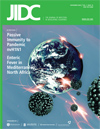Trends in antimicrobial resistance in Shigella species in Karachi, Pakistan
DOI:
https://doi.org/10.3855/jidc.500Keywords:
Shigellosis, resistance, ofloxacin, ceftriaxone, PakistanAbstract
Background: Shigellosis is a common cause of morbidity, especially in the very young and old, in developing countries. The disease is treated with antibiotics. Surveillance of antimicrobial resistance trends is essential owing to the global emergence of antimicrobial resistance.
Methodology: The study involved 1,573 isolates of Shigella species (1996-2007) that were analyzed for trends in antimicrobial resistance.
Results: The majority of the specimens (1046; 66.5%) were from the pediatric population, and of these 887 (84.8%) were under 5 years of age (p = 0.001). S. flexineri was the most frequent species (54.5%) isolated. Isolation of S. sonnei increased from 15.4 % (1996) to 39% (2007) (p = 0.001). Although none of the isolates was found sensitive to all the antibiotics tested, 58% (n =9 07) were resistant to ampicillin and 85% (n = 1,338) were resistant to trimethoprim-sulfamethoxazole (TMP-SMX). Out of a total of 198 (12.6%) nalidixic acid resistant isolates, 6 (3.0%) were also resistant to ofloxacin. Overall 1.7 % of isolates were resistant to ofloxacin, 2.4% to ceftriaxone and 2.3% were resistant to combination of ampicillin, nalidixic acid and TMP-SMX.
Conclusion: Ofloxacin is still an effective drug for treatment of acute shigellosis in Pakistan. Emergence of resistance to ceftriaxone in Shigella may have grave implications in treatment of severe shigellosis in very young patients.
Downloads
Published
How to Cite
Issue
Section
License
Authors who publish with this journal agree to the following terms:
- Authors retain copyright and grant the journal right of first publication with the work simultaneously licensed under a Creative Commons Attribution License that allows others to share the work with an acknowledgement of the work's authorship and initial publication in this journal.
- Authors are able to enter into separate, additional contractual arrangements for the non-exclusive distribution of the journal's published version of the work (e.g., post it to an institutional repository or publish it in a book), with an acknowledgement of its initial publication in this journal.
- Authors are permitted and encouraged to post their work online (e.g., in institutional repositories or on their website) prior to and during the submission process, as it can lead to productive exchanges, as well as earlier and greater citation of published work (See The Effect of Open Access).








